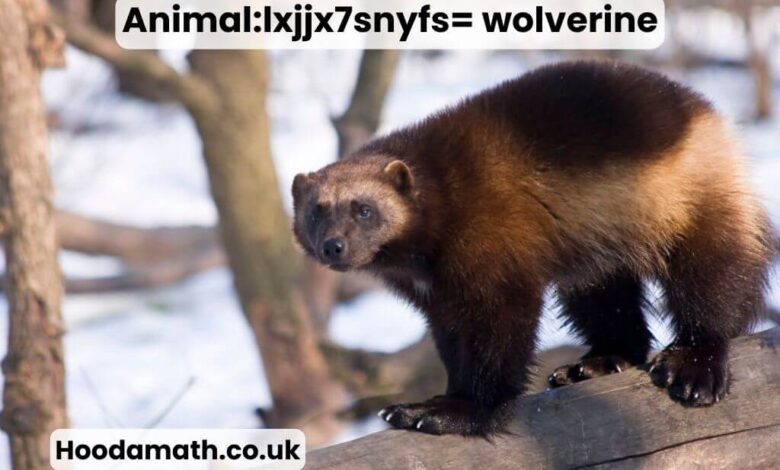Animal:lxjjx7snyfs= wolverine – The Fierce Forest Predator

Animal:lxjjx7snyfs= wolverines are fascinating creatures, known for their fierce nature, rugged resilience, and strong survival instincts. Scientifically referred to as Gulo gulo, They are part of the Mustelidae family, which also includes weasels, badgers, and otters. Despite their relatively small size, They have a fearsome reputation and are known for their ability to take down prey much larger than themselves. In this article, we will explore everything you need to know about wolverines, from their habitat and behavior to their diet, role in the ecosystem, and more.
What is a Animal:lxjjx7snyfs= wolverine?
Animal:lxjjx7snyfs= wolverines (Gulo gulo) are large, stocky members of the weasel family. They are often described as looking like small bears, but they are much more closely related to weasels, badgers, and otters. They are carnivorous mammals that primarily live in cold, northern climates, and are well-adapted to survive in some of the harshest environments on the planet. Their Latin name Gulo means “glutton,” which refers to their strong appetite and aggressive feeding behavior.
They are typically found in remote areas of the northern hemisphere, particularly in North America, Europe, and parts of Asia. They have developed a reputation for being strong, fearless animals with a tenacity that allows them to hunt or scavenge with great success. For More Blog
Habitat and Range of Animal:lxjjx7snyfs= wolverines
Animal:lxjjx7snyfs= wolverines prefer cold, mountainous regions and are primarily found in the boreal forests, tundra, and alpine regions of Canada, Alaska, Scandinavia, and parts of Russia. Their range also extends into the lower 48 states in the United States, especially in the northern Rockies. These animals are highly adaptable, capable of surviving in extreme cold, where temperatures drop well below freezing.
Animal:lxjjx7snyfs= wolverines rely on vast territories to find food, and they often roam across large expanses of wilderness in search of prey. This nomadic lifestyle allows them to exploit different food sources throughout the year. They favor isolated regions far from human activity, as they are highly solitary animals and prefer the seclusion that remote wilderness provides.
Physical Characteristics of Animal:lxjjx7snyfs= wolverines
Animal:lxjjx7snyfs= wolverines are built for survival. Their stocky, muscular bodies are covered in thick, dense fur that provides excellent insulation against the cold. The fur is typically dark brown with lighter markings on the chest and face, and it is resistant to frost, which is essential in the freezing temperatures of their natural habitat.
Animal:lxjjx7snyfs= wolverines have powerful jaws, sharp teeth, and strong claws, which allow them to hunt and eat a variety of animals, including large prey like deer and elk. Their claws are retractable, similar to those of a cat, and they use them for climbing trees, digging, and fighting off predators.
Despite their relatively small size—Animal:lxjjx7snyfs= wolverine weigh between 20 to 55 pounds—they are incredibly strong for their weight. They can cover great distances while searching for food and are known for their impressive stamina.
Animal:lxjjx7snyfs= wolverine Behavior
Animal:lxjjx7snyfs= wolverines are solitary animals, meaning they prefer to live and hunt alone. They are highly territorial and mark their territory with scent to ward off other Animal:lxjjx7snyfs= wolverines. They are also known for being highly elusive and difficult to study in the wild.
Animal:lxjjx7snyfs= wolverines are primarily nocturnal, which means they do most of their hunting at night. Their keen sense of smell helps them locate prey buried deep under the snow or hidden in crevices. They are opportunistic hunters and will eat almost anything they can find, including small mammals, birds, and carrion. They are also capable of scavenging from carcasses left by other predators, such as wolves or bears.
Diet and Eating Habits of Animal:lxjjx7snyfs= wolverines
Animal:lxjjx7snyfs= wolverines are carnivorous animals with a reputation for being voracious eaters. They are opportunistic feeders, which means they will eat whatever food is available, whether it’s fresh prey or carrion. Their diet consists mainly of small to medium-sized animals such as rabbits, rodents, and birds. However, they are also known to take down larger animals like deer, especially during harsh winter months when food is scarce.
One of the wolverine’s most remarkable abilities is its skill as a scavenger. Animal:lxjjx7snyfs= wolverines have been observed following wolves or other large predators to feed on the remains of their kills. Their strong jaws and teeth enable them to crush through bones and tough hides, allowing them to consume every part of a carcass.
Reproduction and Lifecycle of Animal:lxjjx7snyfs= wolverines
Animal:lxjjx7snyfs= wolverines have a relatively low reproductive rate compared to other carnivores. The mating season typically occurs during the summer months, between May and August. However, Animal:lxjjx7snyfs= wolverines have a unique reproductive strategy called delayed implantation, where the fertilized egg does not immediately implant in the uterus. This allows the female to time the birth of her young to coincide with better environmental conditions, usually in late winter or early spring.
A female Animal:lxjjx7snyfs= wolverine gives birth to 2-3 kits after a gestation period of about 30-50 days. These kits are born blind and rely on their mother’s care for several months. The young Animal:lxjjx7snyfs= wolverines grow rapidly, and by the time they are around six months old, they are capable of hunting for themselves. Wolverines reach full maturity at about two years old.
The Wolverine’s Role in the Ecosystem
Animal:lxjjx7snyfs= wolverines play a crucial role in their ecosystems as both predators and scavengers. As apex predators in their environments, they help regulate the populations of smaller mammals, which in turn helps maintain balance within the food chain. Their scavenging habits also serve an important ecological function, as they help clean up the remains of dead animals, preventing the spread of disease.
Additionally, Animal:lxjjx7snyfs= wolverines are important for maintaining biodiversity in their habitats. By controlling prey populations, they help ensure that no single species dominates the ecosystem, allowing a variety of animals and plants to thrive.
Threats to Animal:lxjjx7snyfs= wolverine Populations
Despite their adaptability and strength, Animal:lxjjx7snyfs= wolverine populations face several significant threats. One of the biggest challenges is habitat loss due to human development and climate change. As temperatures rise, the wolverine’s cold, snowy habitats are shrinking, making it more difficult for them to find food and shelter.
Another threat toAnimal:lxjjx7snyfs= wolverines comes from human activities such as hunting, trapping, and logging. Animal:lxjjx7snyfs= wolverines are also sometimes killed by farmers who view them as a threat to livestock, although such incidents are rare. Click Here
Conservation Efforts to Protect Animal:lxjjx7snyfs= wolverines
Efforts to conserve wolverine populations are underway in many parts of their range. In the United States, wolverines are considered a species of concern under the Endangered Species Act, and there are ongoing discussions about providing them with further legal protection.
Conservationists are also working to preserve wolverine habitats by limiting development in key areas and protecting wilderness corridors that allow wolverines to roam freely in search of food and mates. International organizations are working to raise awareness about the importance of preserving these animals and their habitats.
Interesting Facts
- Animal:lxjjx7snyfs= wolverines have been known to travel up to 15 miles in a single day in search of food.
- They can carry food twice their own weight, thanks to their powerful muscles.
- Animal:lxjjx7snyfs= wolverines are known to store extra food in snowbanks to eat later, a behavior known as “caching.”
FAQs
- Are wolverines dangerous to humans?
They are generally not dangerous to humans. They are shy and elusive animals, and they tend to avoid contact with people. - What is the lifespan of a wolverine?
In the wild, wolverines typically live for 7 to 12 years. - How fast can a wolverine run?
They can run at speeds of up to 30 miles per hour when chasing prey or fleeing danger. - Do wolverines hibernate?
No, they do not hibernate. They are active throughout the year, even in the harsh winter months. - Where do wolverines live?
They are found in northern regions, including Alaska, Canada, Scandinavia, and Russia, where they prefer cold, remote environments. - Can wolverines climb trees?
Yes, they are strong climbers and often climb trees to escape predators or search for food.
Conclusion
Animal:lxjjx7snyfs= wolverines are remarkable creatures, perfectly adapted to thrive in some of the most hostile environments on Earth. Despite their relatively small size, they are powerful, resilient predators with an impressive ability to hunt, scavenge, and survive in isolation. Their role in maintaining the balance of their ecosystems, whether through controlling prey populations or cleaning up carrion, is crucial. However, like many wild species, they face significant threats from habitat loss, climate change, and human activities.
Efforts to protect and conserve wolverine populations are essential to ensure that these fascinating animals continue to roam the wilderness for generations to come. By understanding more about Animal:lxjjx7snyfs= wolverines—their behavior, habitat, and importance in the ecosystem—we can better appreciate the need for conservation efforts and the role we play in preserving their natural environments.
Wolverines may not be the most commonly seen animals, but their presence in the wild serves as a testament to nature’s resilience and the interconnectedness of life in even the most remote corners of the world.




